Contents
- Introduction
- Purpose of the Trial
- Judges
- Cultivation
- Notable Delphiniums
- Awards
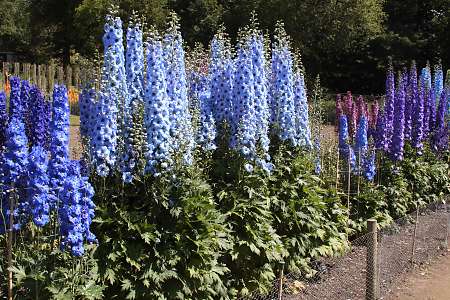
| Return to Main Menu | Return toHome Page |
THE DELPHINIUM TRIAL AT WISLEY GARDENS |
Contents
|
 |
The Royal Horticultural Society's Trial of Delphiniums was for many years one of the long term (permanent) Plant Trials held at their Wisley Gardens. In June and early July it was normally possible every year to see a spectacular display of delphinium flowers in the Trials Field. Major changes in the organisation of RHS plant trials mean it is now unlikely to be true.
2011 marked the beginning of the new era, being the first year of a new style Trial of Delphiniums that will last for three years. The current year, 2013 is the last year of the Trial. Final decisions on Awards will be based on plant performance during all three years but flowering this year is clearly is of major importance, making a visit to the Trial in June or early July particularly worthwhile. In 2012 the Trial provided a spectacular display in early July, which was almost two weeks later than normal due to weather conditions but it should not be assumed that such late flowering will be repeated in 2013.
The 2011 - 2013 Trial of Delphiniums is planted at the western end of the Trials Field adjacent to the Portsmouth road. This is approached by walking from the main entrance to the Gardens to the top of Battleston Hill . In June and early July the flowers of the delphiniums can be seen from the steps that lead down into the Trial Grounds.
The Trial is much smaller than in the past but includes cultivars in a wide range of colours and form. Three of the entries are plants that we have raised.
The purpose of the Trial is to assess the suitability of delphinium cultivars for garden use. Plants judged to be of a sufficiently high standard are granted the prestigious "Award of Garden Merit" (AGM). Delphiniums that produce individual blooms of oustanding quality may be granted Awards that relate to their suitablility for exhibition. The 2011/2013 Trial was intended to include 29 entries, mainly new introductions from delphinium breeders, with 11 AGM delphiniums that provide standards for comparison. The entries are Elatum-Group cultivars and except for 'Sarita' are all of UK origin.
In the past there have also been invited Trials of Perennial Delphiniums from Seed. In 2007 / 2008, the quality of the plants and their flowers was assessed for 46 entries, of which three Seed Selections were given AGM's.
During 2009, the whole programme of RHS Plant Trials has been revised. In future a Trial of Delphiniums will be held only if a proposal for a Trial is considered by the RHS Herbaceous Plants Committee to be of sufficient merit relative to proposals for Trials of other plants. An important consideration will be the number of new delphinium cultivars being introduced and available to the public through the horticultural trade.
The current Trial of Delphiniums at Wisley for 2011 - 2013 was planted in 2010. It has a different format from the earlier Trials for assessing garden worthiness in the period from 1993 - 2010.
Selection of the delphinium cultivars being grown and assessment of the plants in flower is currently the responsibility of the DELPHINIUM Advisory Group (formerly SUB-COMMITTEE), which is attached to the Herbaceous Plants Committee of the Royal Horticultural Society. Historically, this was a Joint Committee with members representing both the RHS and the Delphinium Society. All members of RHS Committees must be members of the RHS but most of the Advisory Group are also members of the Delphinium Society. This group is sceduled to be disbanded at the end of 2013.
The Advisory Group meets at Wisley Gardens with David Bassett as Chairman to:
TRIALS REPORT
The RHS Delphinium Trials and Awards in past Trials are described in Bulletin Number 5, June 2004: "Delphiniums" prepared by Wendy Wesley and Dr David Bassett. Copies of this Bulletin can be obtained from the RHS by writing (enclosing £2 in postage stamps to contribute to costs) to:
Trials Office, RHS Garden, Wisley, Woking, Surrey, GU23 6QB, UK
or via the RHS website www.rhs.org.uk/trials
The RHS website includes many details of the Trials and Awards.
Recent recommendations by the Delphinium Sub-Committee have been:
Perennial Delphiniums from Seed:
For availability of these seed selections, see Topics 3.
The Stuart Ogg Medal for the best display of flowers in the Trial in 2012 was awarded to Delphinium 'Raymond Lister' sent by Mrs J. Bott. This cultivar had beautiful light blue flowers with dark eyes on all three plants from late June to mid July.
Until 2009, a new Trial of Delphiniums at Wisley was planted annually and cultivars were assessed in their second year of growth. Cultivars for the 2011 - 2013 Trial were planted during 2010 and are being treated as herbaceous perennials, remaining in the ground for the period of the Trial. All aspects of cultivation are carried out by the staff of Wisley Gardens.
In the past, stock plants of delphinium cultivars in the Trial were held at Wisley and young plants required for the Trial were raised from cuttings rooted under glass during January and February. Three plants of each cultivar were then planted out in a newly-cultivated Trial bed in early May. This procedure was used for a portion of the 2011 - 2013 Trial as some cultivars were available from stock at Wisley, but the remainder of the entries were supplied by other growers later in the year. This resulted in a less uniform group of plants than in previous Trials. The young plants from May planting grew quickly and were well established by July and most produced an attractive display of flowers in August and September. A similar effect should be acheivable each year in the present Trial by cutting off the stems of plants after their first flush of flowers is over in early July but this was not very successful in either 2011 or 2012.
Under the highly fertile soil conditions of the Trial beds at Wisley most delphiniums grow very vigorously and often develop numerous flower stems. The number of stems is therefore restricted by cutting out the weakest stems in spring to leave about 8 stems per plant and these stems are supported by a 'basket' formed of large mesh pig wire.
The plants are protected against insect pests and fungal disease (especially mildew) by spraying with insecticide or fungicide when this is considered necessary. Mildew was particularly severe in both 2010 and 2011 and a number of cultivars were very badly affected and this has been noted in the assessment of entries. A number of other plant health problems were encountered in the first year, which have resulted in plant losses. In general, the very severe weather during the 2010/2011 winter did not result in major problems. However, there were some problems in 2011, such as lack of uniformity of the group of plants or severe mildew infection. In a number of cases, plant losses resulted in exclusion of cultivars from the Trial during the First Year!
| Return to Contents List | Return to Main Menu |
The first group consists of named cultivars that have already have the Award of Garden Merit (AGM). These are included to demonstrate the standards that other entries of similar colour must reach to be awarded the AGM.
AGM Standards
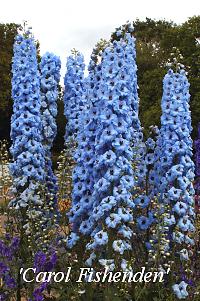 |
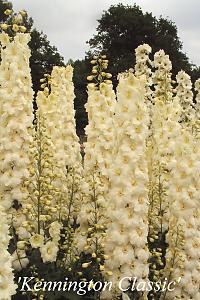 |
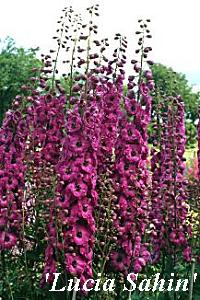 |
The light blue, 'Carol Fishenden' (recommended for AGM 2009), provides a fine display of light blue flowers with a black eye in mid-season. The quality of the blooms is such that it has already become very popular with exhibitors and in 2009 was given a Preliminary Commendation (PC for exhibition). There are currently questions concerning the availability of this cultivar that need to be resolved if the AGM award is to be retained.
Creamy-white delphiniums always look particularly yellow at Wisley and the cultivar 'Kennington Classic' (AGM 2007), raised by the late Terry Murphy and sent by Committee member Ray Joslyn, has been very reliable in the Trials. The flowers are of beautiful form and regularly arranged in the spike, so that the blooms are ideally suited for use by exhibitors as well as for garden decoration. The Stuart Ogg Medal for the Best Display in the Trial in 2006 was awarded to this lovely delphinium.
'Lucia Sahin' (AGM 2001) from D. McGlashan, gained awards quickly. The long, tapering blooms are ideal for exhibitors and this aspect was rewarded with an Award of Merit for Exhibition in 1996 when the fine display also gained the Stuart Ogg Medal. This cultivar marked a breakthrough in the search for deeper colours in the dusky pink range but the near claret colour of the fresh blooms fades very significantly as the blooms age and we would hope newer cultivars to be better in this respect. Lucia Sahin is not a prolific producer of the basal shoots required for cuttings but it is now more widely available as a result of micropropagation and can even be obtained from some Garden Centers.
Other AGM cultivars included are 'Bruce' (AGM 1993) for purples, 'Holly Cookland Wilkins' (AGM 2007) a pale violet with black eye, 'Elizabeth Cook' (AGM 2002), a pure white, and 'Spindrift' (AGM 1993), a reliable old cultivar with long spikes of pale blue and lavender florets often with greenish tinges.
TRIAL ENTRIES
About two thirds of the entries had been in the old-style Trial in 2010, with the others being new cultivars from several sources.The following pictures illustrate a few of them in their first year of the current Trial.
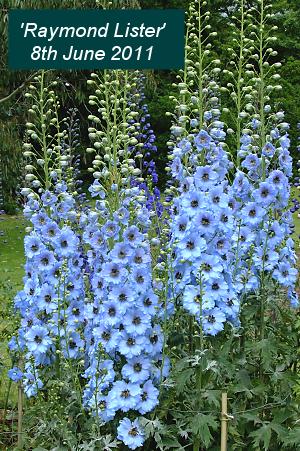 |
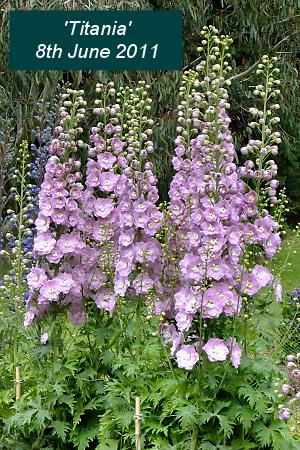 |
'Raymond Lister' was a new entry in the Delphinium Trial for 2009 and the display from the three plants was superb, gaining this cultivar a first commendation on the route to AGM. The plant was raised by amateur delphinium enthusiast, Joyce Bott, who named it in memory of Mr Lister who looked after Mr and Mrs Wainwright's famous delphinium garden, 'The Heath', at Adel near Leeds. It produced another excellent display of blooms with a plentiful supply of lateral shoots prolonging the display in 2011, although the foliage was affected by mildew. The display produced by a superb, uniform group of three plants last year was of exceptional quality and this cultivar was the winner of the Stuart Ogg Medal for the best display in the Trial in 2012.
The 2009 Trial had several other new entries that are in the current Trial, including two cultivars from the current Blackmore & Langdon Catalogue, deep purple/blue 'Amadeus' and 'Titania', a light pink with white eye. The flowers of 'Titania' are beautifully formed and the colour is exceptionally clear. Although the groups lacked uniformity, the plants have provided eye-catching displays and 'Titania' was rewarded in 2011 with the Stuart Ogg Medal for the best display in the Trial.
Another cultivar that has attracted much attention has been John Flowerday's 'Ruby Wedding' with well formed blooms of very deep crimson (cranberry pink)florets with white eyes.
Over recent years, John Barrington of Newport Mills Nursery at Wrantage has been a major contributor to the Wisley Trials, both in supplying plants and in sending cultivars that he has raised, including three new ones for this Trial.
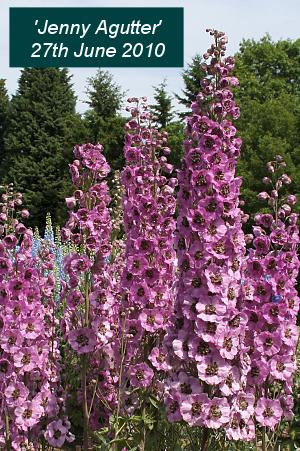 |
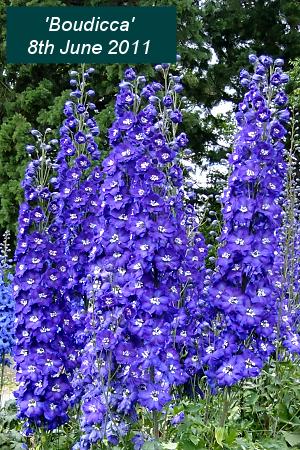 |
'Jenny Agutter', a fairly deep pink notable for broad tapering spikes and a very large dark eye, was in previous Trials but 'Boudicca' is new and in 2011 provided a fine uniform group of vigorous plants with large blooms that looked to be excellent for back of the border positions.
Another more recent contributor of new cultivars to the Trials is Gordon West of Dishforth Nursery Gardens in Yorkshire. His un-named violet seedling GW-1 was excellent in the previous 2009 Trial and is now accompanied by GW-6 a deep pink and GW-7 a deep purple, both of these having exceptionally large florets. Unfortunately, heavy rain at flowering time in 2012 proved the downfall of GW-7 since the large florets and blooms collapsed.
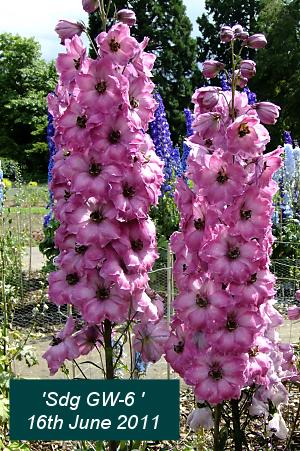 |
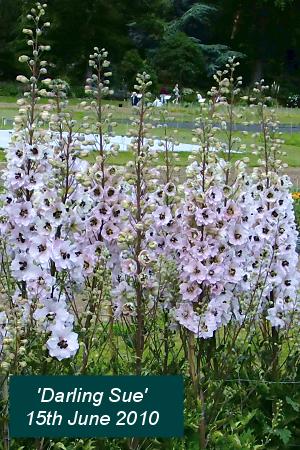 |
While GW-6 seems to be rather late blooming, another of the entries in the pink section is 'Darling Sue', raised a good many years ago by Jim Cook but sent for Trial by Blackmore & Langdon. This blooms exceptionally early in the season and has pretty pink-tinged white flowers although they fade rather quickly.
The performance of all these cultivars will be watched with great interest along with that of our three cultivars from Cherry Barn that are entrants in the Trial. The two cultivars raised by Shirley, one a light pink and the other a deep blue, both flower rather late and were in good form in mid-July last year.
| Return to Contents List | Return to Main Menu |